With Rebecca Ashton
If anyone knows about the ups-and-downs of dressage, it’s Brett Parbery. A lifetime of horses has seen a roller coaster ride that is heading back to the heights once more. In this three part series, Brett shares his life, training method and the future he envisions for Australian dressage…
“My interest in riding came from my father who is a horse trainer, and a very, very good horseman. Dad really loves the horses and is incredibly patient with them. He has invested his whole life into understanding how they think, horsemanship, rider position and the system of training a horse. He’s always said to me, ‘If you want to test your horsemanship and training, you have to compete because nothing can be hidden in competition.’”
“That’s why I’ve always had the urge to compete. Growing up in Dorrigo, a very small town just inland of Coffs Harbour, you didn’t get exposed to dressage as such. I went to Pony Club and my sister was into showing a little bit so we went to Ag shows and Royals. In those days campdrafting, showing, rodeo and showjumping were all held in the same place on the same day. My father chose campdrafting because he likes cattle and we have a cattle property.”
Brett’s father, still the greatest influence…
“Dad was the one responsible for sorting out my position so it was pretty much how it is today. I struggled a couple of months as a 13-year-old boy being prepared for Brisbane Royal. I remember Dad saying to Mum, ‘I don’t think he’s ever going to get it’. For some reason the next day I got it. I can’t remember the exact trigger, except that it was a determination to prove him wrong. I remember feeling the first time my position clicked in, and its been the same ever since. Mum will tell you that.”
“As I got older, 15, 16, I started to play a bit of polocrosse. Showing had become too boring. That was when my interest in horse training began. My daily routine was come home from school, have a bit of afternoon tea and then catch all the horses and ride through to 8:30 – 9, at night. My mates would come over on their motorbikes and sit in the middle and I’d ride around them so I could talk to them and train the horses all at once.”
“My interest in horse training grew and Dad’s relentless discipline to stay with dressage principles was my guide. He really loves dressage and has read every book; Baucher, Podhajsky, Duke of Newcastle, he’s read them all. He’s really a student of it. However, I asked him if he would watch my DVDs and he said no! Haha.”
more follows
“Even now he has a chip at me for my position, ‘You’re not sitting straight enough, you’re not balanced enough,’ all of that, he’s really sharp on it. I try to explain to him that you don’t have to be absolutely perfect. But possibly you do; in his eyes you do. He really hammered home three things to me: feeling, timing and balance.”
“We would sit at the dinner table every night and discuss horse training. Mum would go and watch television. I was keen to discuss training, and I still think dad’s as good a rider as I’ve seen. I put him on Victory Salute once and let him feel piaffe. He jumped on with a pair of jeans, and he got the feeling. I would love him to be my eyes on the ground, but he tells me he doesn’t know anything about where I am now in dressage, but I know he would see things.”
Brett had a well-rounded education, including camp drafting and polocrosse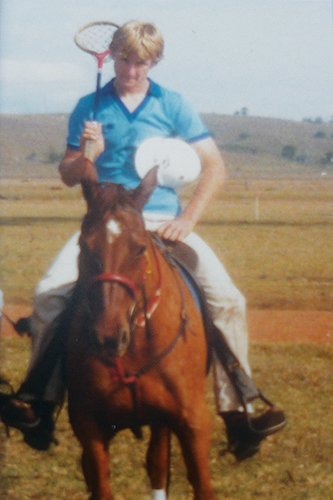
“Next I went to rodeo riding, and was living the life-long goal of riding on the professional circuit in America. I wasn’t a particularly great saddle bronc rider, but I was competitive. It was also a desire to be part of the cowboy culture. I loved it. I was very happy being a cowboy and living the cowboy way.”
“Eventually though, I wanted to get out of rodeo as the fire had gone out. I can still remember the moment. I was 25/26 and we were going from one rodeo to another, driving through Wyoming and we stopped at a service station and I bought a Dressage Today magazine to kill time. Sitting in cars for 30-40 hours is boring at the best of times. I was starting to think about what I was going to do after rodeo and I was actually thinking about being a cutting horse trainer, but I was a property valuer living in the Hawkesbury and I thought I can’t get access to cattle there, so then I thought I’d go into reining. But there’s a part of me that really loves sport and I really wanted to represent Australia. I thought eventing, but felt I was a bit too tall. William Fox-Pitt has since proven me wrong! Showjumping was not really for me and I didn’t really have the money to do it. So dressage it was.”
“It’s funny what happens when you put things out into the Universe. I returned home in August 1998 and I was valuing a property. I mentioned to the guy that I wanted to find a dressage horse, or someone to train dressage with, and he said, ‘I know someone, Vicky Brydon. She’s hurt her back and she has an FEI mare.’ I didn’t even know what FEI was but I rang her. She said to come around and have a test ride. Her conclusion was, ‘You have a lovely position and a lot of natural talent but you know nothing about dressage. I’m willing to coach you everyday in return for you riding my horse. You don’t pay me, I don’t pay you, and we go from there.’”
“I did my very first dressage tests about December the same year in Prix St George and Inter 1. I was just basically hopping on and pushing the buttons that Vicky told me to push and the mare, Liebling was so lovely and so honest and so well trained that I could do that. I had been helicoptered into this. Midway through 1999 I won NSW State Championships Inter 1 at Dubbo.”
“During 1999 there were a few people coming out from overseas scouting around preparing for the Olympics. Janet and Chris Haazen came out and were looking at things for the Dutch teams and were guest riders at the CDI. They saw me ride and said I should go to Holland and they hooked me up with a few people and away I went.”
“I went there as a 28 year old and bounced around Europe looking for gigs. I was very naive and I thought I knew it all. Over there they see through you straight away and sure, you can sit pretty, but you have to train a horse.”
“So, I got put at the bottom of the pile and that was really tough but I stuck it out for a couple of years. First of all I was with Jet Van der Steen and Klaas van Doorn who have since become close family friends. They are great connections for me too and have helped me find horses for people over the years. From there I went to Denmark and rode for John Byrialsen. That was a disaster!”
“Then I came back to Belgium and rode for a year with New Zealand showjumpers John Grey, Ann Symes and Bruce Goodin. They were called European Sport Horses and were the biggest exporter of jumping horses out of Europe into America. Bruce was the stay-at-home trainer, John bought the horses and Ann sold them. Bruce was a very, very good horseman and rider. Going into the gold medal round at Sydney 2000, he was leading.”
“He really took me under his wing and I did all the flat work training on the horses. He wanted them to go like dressage horses. He would say to me, ‘I want my horse to feel like this and this is how I want it to happen.’”
“It was perfect for me because not only was I getting lots of rides, but I was really focused on basics, no movements. Basic walk, trot, canter. Being able to turn at any moment, lengthen at any moment and collect at any moment anywhere in the arena. It was fantastic because it kept it simple.”
“It was not like going to a German stable where someone’s been holding onto the front end and whipping the back end. None of this false feeling, just soft, round, loose and connected. It was a wonderful time.”
“I came back from there and then the opportunity came up in April 2004 to go to Jenny and Phil Rapson’s Suntori Park because Matthew Dowsley and Rodney Martin who had been based there had bought their own place.”
“That’s when it really all started to take off. I was still valuing property with the mob I had been with all along in Penrith. They were great because they let me ride and work. They were very understanding and if it had not been for the flexibility of my boss Kent Wood, I probably wouldn’t be doing what I’m doing now.”
At DJWTS in 2004, starring in the Young Horse on RPH Raquel
“I was riding for free, for cheap to get myself on the map. I knew I had to win something big and the easiest thing to win quickly was a four year old class. So, I bought a four year old and had another one which came to me via Rachel Hunter. I went to DWTS in November and came first and second in the four year olds.”
“During that year I also went back to Europe and rode with Holga Finken. I thought if I was going to do this, I needed to keep going back to Europe on short stints. Chris Hector lined it up for me and I went for six weeks.”
“I also met my wife Mel in 2004 as well. It was a big year! Her parents had bought Rachael Downs’ parents’ property which was just around the corner. Mel’s father rang me up one day asking to send a mare over because his 22 year old daughter couldn’t ride it. Within the first three weeks, the horse actually went lame and I had to tell them to take it home so I didn’t have much time to suss out if this girl had a boyfriend or what. I was wrestling with the idea of sacking the horse because I hadn’t found out all the info about the daughter!”
“I knew she was a graphic designer so I got her to design a logo for me which bought me another couple of weeks and then it all went from there! We have been together since September 2004.”
“Kerry Mack had watched me ride at DWTS and that got me Razzamatazz and then Whisper. It was Whisper that put me out there. He was about nine and Mary Hanna had done a Grand Prix on him previously.”
“I got Whisper just before the Sydney CDI in 2005 and took him to the stallion show at the CDI.”
“The business at Suntori expanded to the point that I had 12 horses in work whilst I was still working as a valuer. I was valuing all night, riding all morning, inspecting properties all afternoon. I think that’s also a good message to get there to the kids that want to be professional riders. You have to put in the hard work and have no life for a while.”
“So, Whisper won a lot of small tour tests in 2005 and in 2006 he was the Australian Grand Prix champion at the Nationals. I had good people working for me then too, Jayden Brown, Nick Fyffe and Tania Seymour who rides for South Africa.”
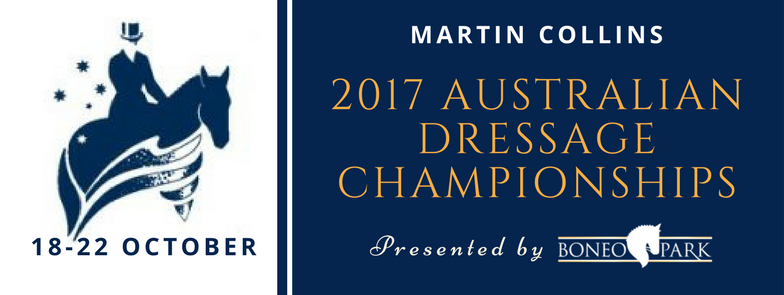
“I had a horse called Challenger Achilles owned by Rochelle King. He was the horse I made my first squads on. Ulla Salzgeber was the Australian coach and at one point she asked me to bring Whisper. She wasn’t the biggest fan of Whisper but she had a vision. Matthew Dowsley had taken over the ride of Victory Salute from Rodney and was doing a bit of Grand Prix, but Matthew also had Cinderella which was his number one horse. So, Ulla had the vision of me taking over the ride on Victory Salute. She believed she could make the Australian team good if she could get the riders she wanted on the horses she wanted. That’s how she tried to construct it.”
“I knew I was going to be bringing Whisper to Grand Prix in 2006 but I had never ridden Grand Prix. I asked Ulla what she did at Christmas time and she said muck out stables because all the staff go on holidays. I said I’ll come and do it for you if you can give me some sits on some Grand Prix horses. I was fiddling with Challenger Achilles but I didn’t really know what I was doing. So, for three months, I got a lesson on Rusty five days a week for free. It was the Vicky Brydon scenario all over again.”
“Rusty was tough to ride; to motivate him, to get him through enough. When he was there, he was amazing, the feeling was amazing, but to get him there, you had to know what you were doing. There were some days she just said get off, I’ll show you, which was great.”
“While I was mucking out stables at Ulla’s one morning, the phone rang. It was Carolyn Lieutenant asking if I wanted to ride Victory Salute. I ran up to Ulla’s house and said, ‘You’re not going to believe it. I’ve been asked to ride the horse.’”
“I don’t really know if that seed was planted by Ulla in Carolyn’s head, I’ve never asked her. Matthew and Rodney had decided to take Cinderella to the World Cup final to make the Australian team for WEG at Aachen, which left Carolyn’s horse without a home so Carolyn had to find a rider.”
“When I came back to Australia in March, I had Whisper and Victory Salute verging on Grand Prix. In 2006, my stable of horses was incredible. The Nationals that year were massive for me. I had Fisherman’s Friend – medium champion, Whisper – second in the Grand Prix and first in the Freestyle, Victory Salute won the National Grand Prix but on his score would have been second in the World Cup Grand Prix, Northern Simba was five year old champion, Samsara Hit was four year old champion.”
“At the end of 2006, Matthew came back to Australia. He had been the best placed Australian at WEG and I was the Australian Grand Prix champion that year. Matthew and I went head to head at DWTS and Matthew just pipped me. That was the moment I thought,’ I can actually do this. I can give it a good shot.”
Brett and Victory Salute – best of the Aussies at Aachen
“Whisper went back to Kerry’s for summer in 2006/2007 for breeding and a break while Victory Salute stayed with me in training. The Dressage Festival was in March and I made a big mistake. At a World Cup show, you can’t have two horses in the freestyle and I was pretty confident that Victory Salute would score better so I said to the owners the best placed horse in the Grand Prix will go through to the freestyle. I naively thought that’s how I would organise it. But I found out that afternoon I had to declare which horse I was going to ride in the CDI-W. I hadn’t had a chance to talk to the owners so I just said Victory Salute.”
“Whisper beat Victory Salute so I got blasted by Kerry and Whisper then left me. He actually came back to me in about 2010. Pretty much the fight we had only lasted one week.”
“July 2007, I resigned from my valuation job to ride full time with the intention on riding in 2008 Olympics. In August 2007, EI hit! So, Brett’s knocking back on the property valuation door! At that time, Mel and I had bought the property in the Southern Highlands. We got there with the big mortgage and EI shut the country down and I couldn’t do anything. So, I was coming up to Sydney, valuing and staying overnight, going back home the next day.”
“Then it was time for the teams qualifications for the 2008 Olympics. Because Australia couldn’t travel horses anywhere, they had the Australian team ride in Australia, the Japanese team ride in Europe (which Maree Tomkinson rode in) and the New Zealand riders rode in New Zealand and the judges flew between events. I got selected on that team which was my first taste of that end of things; you’re on a team, you have to get your paperwork sorted, the pressure is on you.”
“I love that pressure. If there’s one skill I learnt from rodeo is the ability to be able to go within myself and focus, which I think is one of the reasons why I can ride tests and why I can handle pressure. With rodeo there is an incredible camaraderie and you can get nervous, but you can’t get silly about it because everything in rodeo happens too quickly. You’ve got to react. It can’t be a thought.”
“Four team horses went to SIEC. It was quite an eerie feeling with no other horses around. I was the highest score in that qualification. I equalled the score with a Japanese rider. With the backing of the high performance programme at the time and the backing of Carolyn, we decided to give the Olympics a run. Hubertus Schmidt had just been in Australia and I had got on quite well with him so I decided to go over to him. Mary Hanna was already based there with Port Said, Tango and Rambo, so we shared a flat.”
“I left Mel at home running the place with a couple of staff. My wife is a saint to allow me to travel all over the world doing all this! I had always been to Europe as a worker but this was my first time as a client and it was a completely different experience. You get the trainer’s time and their advice. I really thought Hubertus was one of the masters of the German system. He is a great guy; he likes his boxing, he likes to drink beer, he likes to be around his mates and he’s a family man, he’s not just all about dressage.”
“The training there took us to a new level. Also living with Mary was great. She taught me a lot about the details of show entries and making sure you have the truck booked, vets sorted, all the little details. Mary leaves nothing to chance. That, I think, is one of the secrets to her success. She is very intelligent with the way she plans what she is doing. She taught me a lot of skills.”
“You’ve got to have some disappointments in this game. 2008 still sits a bit wrong with me. It was a messy year. I had gone over as the highest scoring Australian from the teams qualification event but we changed things with the horse that had to be changed. Maybe in hindsight I didn’t leave myself enough time because the first selection event was in Wiesbaden and I didn’t have the best show. I think I scored 62%.”
“The next selection event was at Lingen and I was the third best Australian. After the second selection event, I was the best placed Australian at Aachen. That wasn’t a selection event, but I felt I was on an upward rise. I thought I was now on a good way and that there was a fair chance I was going to make the team. It was not to be, but there was no Facebook in those days. You kept it to yourself, you shut up and you copped it on the chin. But not only did I get left off the team, I didn’t even get to go as a reserve. My horse had been chosen as a para horse for Georgia Bruce so it had to go to Hong Kong anyway, so, go figure that one out. They talk about saving money and everything…. That for me was very disappointing. I thought this actually isn’t fair and I went home and sent a savage email to those involved.”
“After Aachen, I drove the horse back to Hubertus Schmidt’s place, said hello to Georgia Bruce (who went on to win bronze), handed over my whole tack box and my horse and got on a plane and flew home.”
Brett Parbery – The Trainer – Part One:
Now Brett shares his training methods with you…
For me the key to training and riding boils down to three components:
– Basic riding position and how you deliver your aids
– Horsemanship…applicable to all horse sports
– Training for your specific discipline
I worked hard on my position so that was pretty well established and I’ve been able to deliver my aids. That came from all the training with my father. I always had the horsemanship too. I was brought up with horses and it’s all I’ve really ever done. Then came the dressage training. I was adventuring as much as anyone else. You’re watching the Ankys and you’re seeing the very round and then the guys that ride them up and I was really as lost as everybody else is.
The main influence for me was originally when Ulla Salzgeber got involved and I loved the way she rode; I loved her position. My vision of dressage is when the horse looks like a rubber ball and they’re really short and athletic and springy with lots of energy. I loved the way she made Rusty really round and short and energetic. He looked really active and really on the edge without tension. I also loved her philosophy when she started training the team here.
The Teachers…
Then Hubertus Schmidt. I loved the way he was a very good horseman and had a great system of training which was a good reflection of the classical system. Then Edward Gal who I thought was the best representative of the Dutch system. I felt that maybe Anky and Sjef developed the system but I loved the way Edward rode. He’s probably been my favourite rider since I met him in 2000. I like the way he gets the horses really balanced back on the hindlegs and uphill, really up in the wither. I think he can do that better than anybody. I like where Edward puts his body. He keeps back off their wither and lets them get in front of him.
All three of those riders share one common factor, that is they all ride with a very loose upper leg and they give horses freedom to really expand in the back and work up through the back. They’ve all got beautiful contact and nice steady hands. Of course Edward rides them rounder and Hubertus doesn’t ride them short and there a lots of different things like that, but they all have good contact and they all ride with a beautiful, soft upper leg and a lower leg that commands response. They’re the things I keep in the back of my mind when I watch those guys riding.
As far as my training, over my time learning from those guys, I’ve been trying to work out how it’s possible to do this from Australia. How can we be as good as we can be without access to the information and without the pressures of the competitions month in month out pushing people to a better level. I get some eyes on the ground here but I don’t get a lot of coaching simply because people are busy and so on. I guess my thing has always been I can’t ride around with someone else’s voice in my head. I have to be responsible for my system, my aids and how my aids are working and how my horses are responding to them. So I thought, I’ve trained with the best, I should be smart enough now to be able to pick the best from the best; what do I like and how does it work. So I went through it and I tried to work out what components are there in this sport. So I believe there are three:
1. Frame Control: that means the control of the outline of the horse from the poll to the tail. That is largely dependent on a horse’s body type, whether it be a high necked horse or a low necked horse with a strong back or a weak back. There will be a place where the frame works the best. It could be one centimetre here, one centimetre there, but there will be a place where that horse works best in that frame and my job is to find it.
2. Feet Control: I believe when dressage is done well, it should look foot perfect. I should be able to control the feet of the horse. So first I thought what are the aids I know to control the front feet of the horse, that essentially is turning aids. When you ask people what their turning aids are, it can be really interesting. Some people are trying to turn horses with their legs, some by where they look but you know the only thing that will turn a horse’s shoulders are aids specific for that part of the horse. So if you try and do it with your legs, well your legs control the back end of the horse. So I came up with – I turn my shoulders – because we all know that with shoulder in or half pass, you’re supposed to turn your body to the position you want the horse’s shoulders to go in. So I thought, right, that’s the only aid I’ll use, turning my shoulders and turning the horse from the outside rein so I shift the space between the reins across and turn my body.
So now I need control of the hindlegs. We all know that you use the leg behind the girth to control hindlegs.
3. Transition Control: All dressage really is transitions. For example, by Grand Prix, you should be able to control seven versions of trot. They are: pony trot (the small one), working trot, collected trot, medium trot, extended trot, piaffe and passage. I believe that in the system of controlling transitions, there’s really only five transitions you need to control. They are upward transitions, downward transitions, transitions forward in the pace, transitions collecting the pace and tempo control within the pace, getting the horses to move more active or quicker within a canter or trot or piaffe stride, for instance. That last one is hard. I need specific aids for each transition I want to make.
I thought if I can control frame, the feet and all the transitions, I have all the tools I need to ride a Grand Prix test. I just need to get better at applying them. That gave me a very clear system in which I wanted to train my horse. It is giving me a very clear structure so that I don’t get lost anymore. I might get a little bit lost within my own system because sometimes you lose a bit of feel, but I don’t think, “Oh Edward said this and I don’t know what he meant.”
I am now responsible for my own aids. That’s been a big thing for me. If I can make each of those things the best it can be in each horse, then I’ve brought out the best in each horse – which is the brief.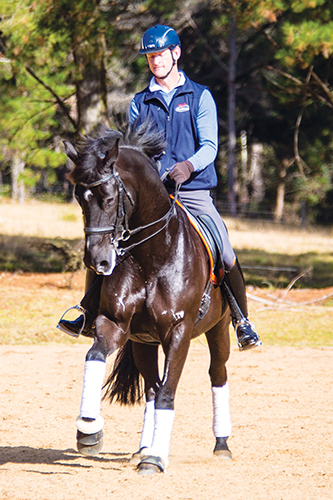
All of the exercises that I’ve learnt over the years I can attach to one of those three components because when you think of the most complex movement, a canter pirouette for example, that’s an exercise where all the aids are on at once; frame control, stay round, stay through; transition control that says stay in front of my leg but actually let me collect you in canter, within the frame, and then let me turn your shoulders around your hindlegs and let me control your front legs from there to there and your hind feet to there and be able to control each of those aids. Pirouettes are the most complex. All the aids are layered together in a discussion with the horse that says, “Do a canter pirouette.” That’s really all it is. The aids are words and layering them together creates a sentence. That’s the communication between you and the horse. When I realised I could be responsible for my own aids, it cleared so much of it up.
Weltmieser (he’s by Weltmeyer and out of a mare by Dutch Gold)
He was born and bred in Tamworth. His dam was a mare that Brian and Barbara Maheine and their daughter Susie Duddy imported from Jennie Loriston-Clarke. He was broken in by John Squires, before going to Heath Ryan who got him to Medium. The horse then got this thing on his face and he had to have nine months off before coming to me as a five year old – he’s 13 now.
He’s a short, strong backed type horse, he has a great canter which I love and a good basic swinging trot. He had a good trainable temperament. Luckily the owners really trusted me and I brought him up through the levels. He’s probably lost about a year’s worth of training with me being away so much. He did his first Grand Prix in Orange last year with 67%. He’s always been good in the ring and he’s actually been quite easy to train. They’re all tricky in some way, but he’s on the easier end of the spectrum. I’ve trained him to be almost a bit too reactive to my leg. He has a body shape that allows him to respond nicely to the half halt and he’s obedient.
I work him a lot in middle frame. I never really ride them up at home. That last little bit of up needed for competition is created from energy and half halts through transition control.
There are times I’ll take him deep because he still needs to get strong in the back but I try to get him strong in middle frame because he’s already built low set in the neck and strong in the back.
Interestingly talking about body type, when I was in Holland I was talking to some breeders about Totilas. The Dutch breeders like them really up in front and strong and energetic, especially when they don’t have to ride them! I was talking to one breeder and he said Totilas was an old fashioned type. I’m thinking modern, high neck, weak back, thin legs that break down? Give me an old fashioned type any day. There should be no old fashioned or modern, there should be good or bad. Totilas I believe is a good type, well ridden, good brain. I think there is a lot of disconnect from a lot of breeders about Grand Prix. The commercial market wants a horse that looks like a finished Grand Prix horse at four years old. We all know the finished Grand Prix horse trots and canters because they’re trained to do that. The people who bred Totilas foals over in Europe were saying oh he’s disappointing, the foals don’t move and I’m thinking hang on, that’s because Totilas doesn’t move. He’s been trained and developed to do it.
I like a good canter, which is balanced from day one, an elastic walk that’s not too big and a trot that is just rhythmical and balanced, not big and fancy. I also like a body type where I don’t have to ride around trying to put the horse’s neck down the whole time to try and get their back up.
The hardest thing about Weltmieser are the pirouettes. He bends his hindlegs well in piaffe but he’s built a little bit straight in the hind legs so when it comes to the pirouettes and canter, he just does not like them. I can’t tell you how many kilometres I’ve done of exercises but in the ring he’s just a little bit scared of them and sometimes takes over. He needs to learn to leave it to me to take him to a place that he can do it and it’s comfortable for him. Just stay here and balance and wait for me to control it. I can’t put my finger on it why, but I need to be responsible for it and I need to break it down and find the exercises to fix it and give him time.
VIEW PART TWO:
http://www.horsemagazine.com/thm/2015/09/brett-parbery-life-and-times-part-two/

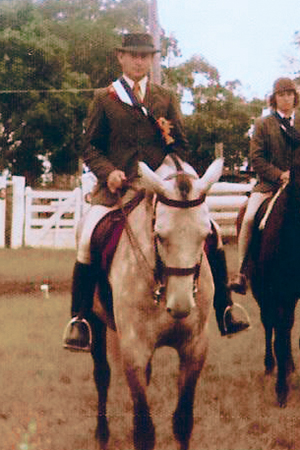
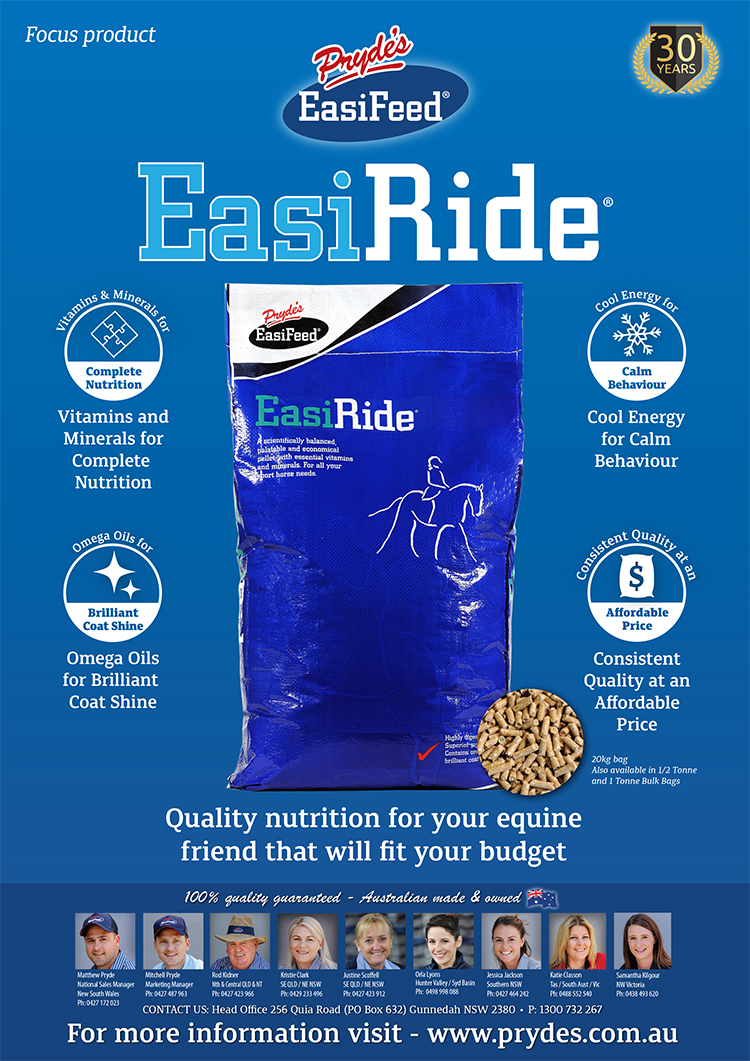
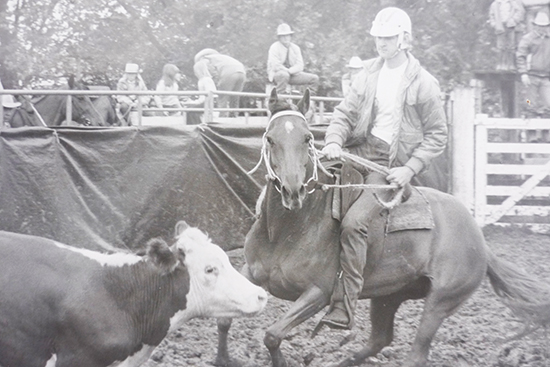
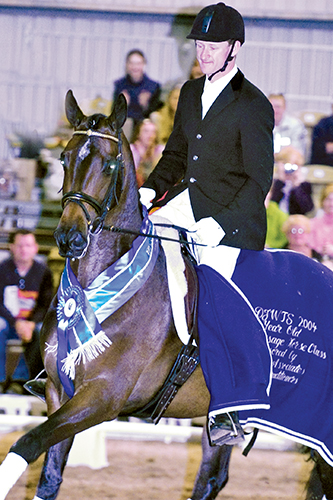
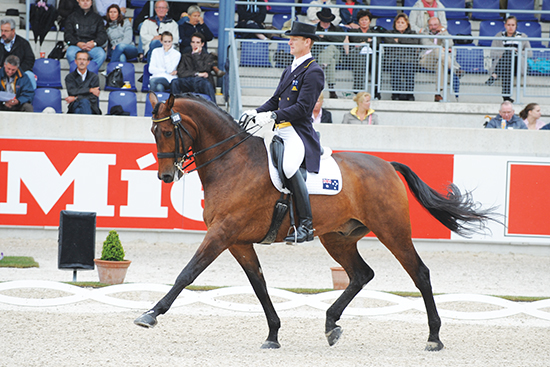
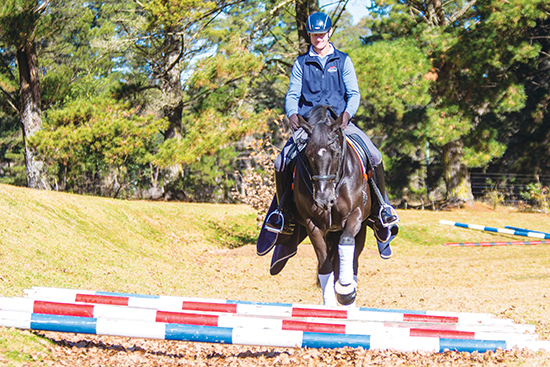
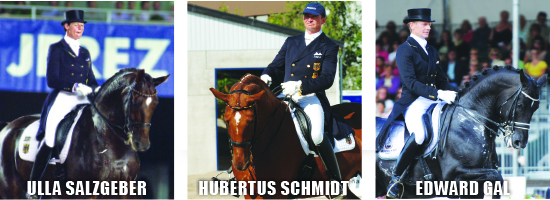
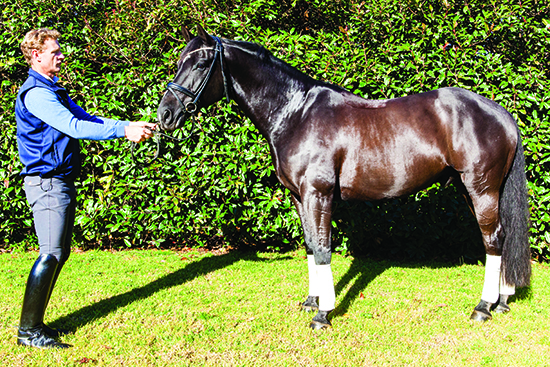
Such a refreshingly honest and open story. Thank you.